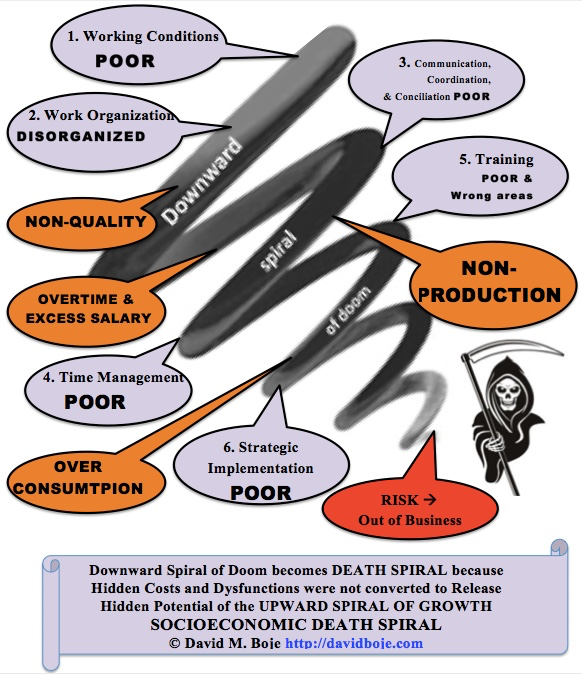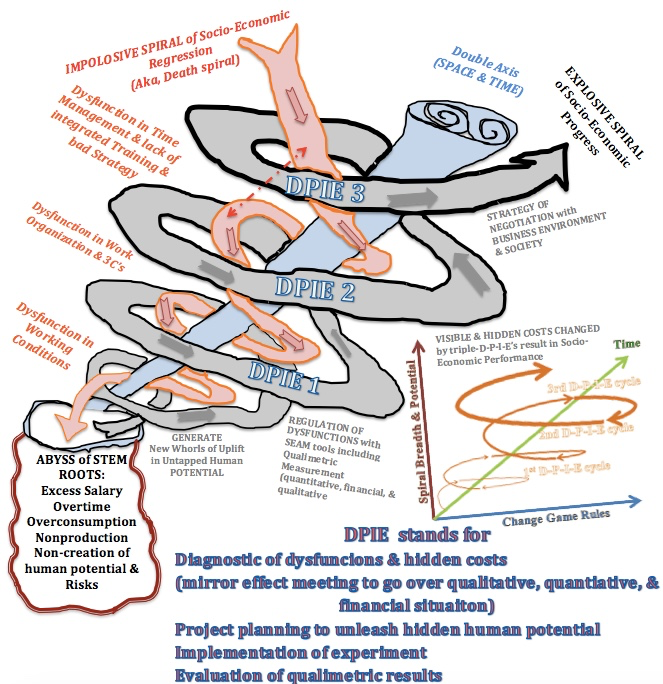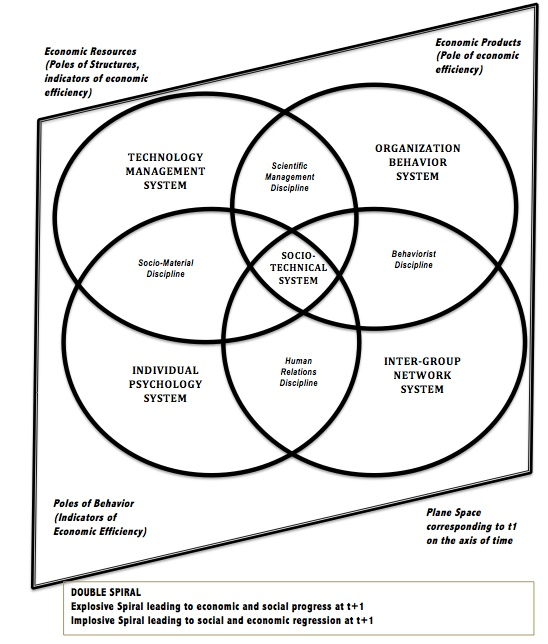Organizational Research Methods: Storytelling in ActionDavid M. Boje Book being prepared for Routledge, due March 2018 To cite this document: Boje, David M. (2018) "Organizational Research Methods: Storytelling In Action", (March 15), URL = <https://davidboje.com/ORM_Storytelling_in_Action_Book/index> |
STREAM 6 - Henri Savall's Positive Dialectical Scientific Method for Consultation with Socioeconomics, Qualimetrics, and Social Responsible Capitalism
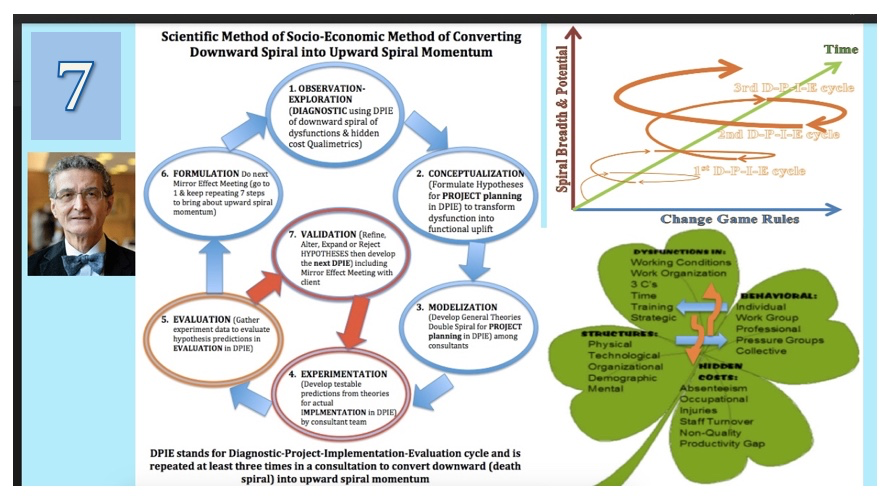

David Boje presents How to Change Military Industrial University Complex into socially responsible capitalism? Boje recommends Henri Savall's socioeconomics approach to scientific, positive dialectic. Building teams to do 3 or more DPIEs (Diagnostic, Project planning, Implementation, & Evaluation) that builds upward spiral to counter the Death spiral of the military-industrial-university complex. Boje and his faculty and therapist team also demo 'EMBODIED RESTORYING PROCESS' to work with military families post-deployment using 'stand table' approach to material storytelling. Thanks to all who participated. More on socioeconomic interventions at https://davidboje.com/448 and for doctoral level work see https://davidboje.com/655 Savall Study guide.
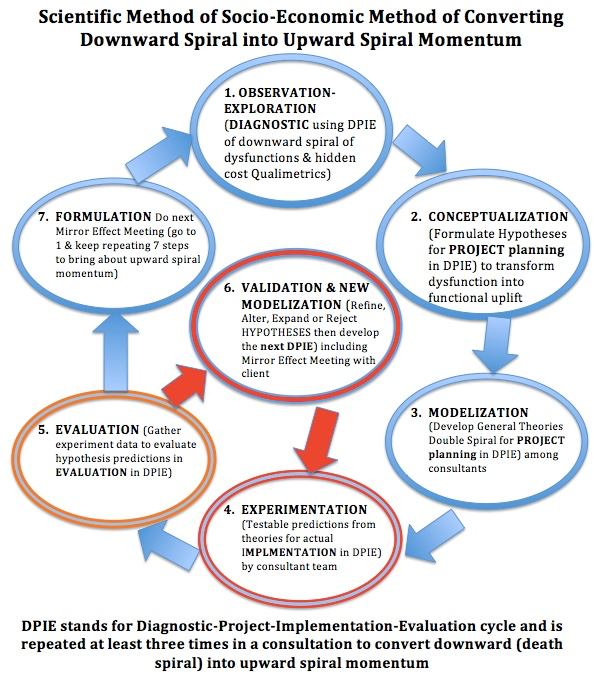
Figure 1: Seven Steps in Scientific Method used in SEAM to Transform Death Spiral Dysfunctions into Upward Spiral Momentum (original figure © D. Boje November 5 2017)
First Question: When does SEAM begin using Scientific Method as a 'quest for truth' in its Business Consulting?
SEAM (Socioeconmic Approach to Management) is a continuing “quest for truth” and “progression of individual scientific work is accelerated when researchers oblige themselves (or are obliged) to exteriorise themselves in dialogue or in writing (principle of cognitive interactivity” (Savall & Zardet, 2008: 145, 148, note I reversed order of last two steps, and changed wording of the steps):
- Exploration in Diagnostic phase of DPIE
- ConceptualizationIn-Depth Observation
- Modelization
- Experimentation by implementing co-created projects (horizontally and vertically, in HORIVERT).
- Evaluation
- Formulation of relevant and knowledge to be disseminated
- Validation
In taking verbatim field notes, making observations (& transcribing interviews & meetings) the researcher-intervenor is able to detect just how disorganized the theatrics of the organization have become. The SEAM Mirror Effect, lets the client confront the organizational dysfunctions and hidden cost situation before the project planning. In this way the client can spend a moderate amount on the change intervention in-order-to save a major and significant amount in achieving greater socio-economic and financial performance, improving working conditions, and developing a democratic participation of project teams. The diagnostic is represented in this 4-Leaf Clover model, that shows (in blue) the main Theory (big X->Y) cause-effect relations, and the six stem roots of economic and financial consequences.
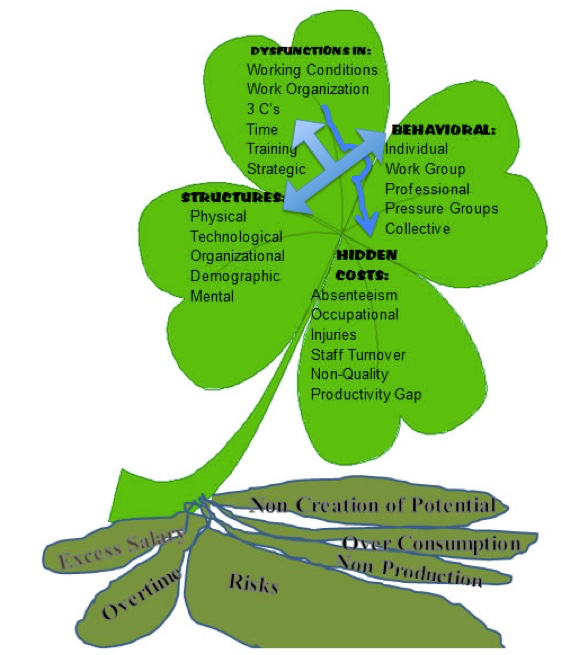
Figure 2: 4 Leaf Clover Rendition of SEAM with root causes and in Blue the Big (X->Y cause-effect relations) (drawing by Boje, 2017)
Integrated training and strategic implementation has the effect of reducing the multiplicity of hidden costs (Savall & Zardet, 2008: 298, Hidden Costs book).
Second Question: How is Charles Sanders Peirce's Triadic of Deduction-Induction-Abduction related to SEAM's Scientific Mehtod?
Savall and Zardet (2008: 21) cite Peirce’s (1955) logics of induction, education, and abduction, but prefers to move from abductive hypothesis selections from many possible ones, to deduction, and finally inductive reasoning. This is seen as a dialectical synthesis of the Peircean three logics of reasoning (Savall & Zardet, 2008: 20). It is seen as an ovulating wave or flow of collected and disseminated qualimetircs in alternating series of deduction, induction, deduction, induction, and so on, a dialectical movement of knowledge structuration (Savall & Zardet, 2008: 206).
Third Question: What is DPIE's Use in Building Upward Spiral?
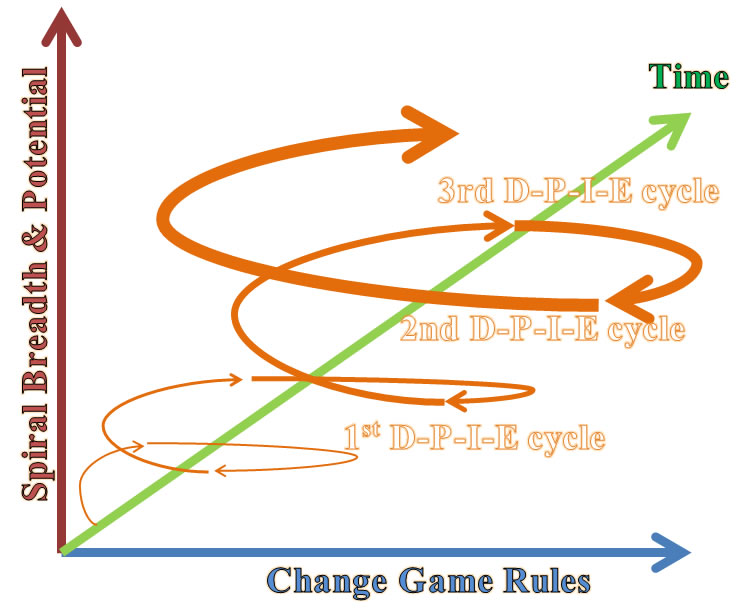
Figure 3: Diagnostic-Project-Implementation-Evaluation cycle (DPEI) done 3 times in a consultation to builde Upward SPiral Breadth and Potential and to Change the Strategic Implementation of Game Rules (drawing from Boje 2014 book, and used past 18 years in teaching SEAM in Mgt 448 and Mgt 548 at NMSU).
Fourth Question: What is a Death Spiral in SEAM?
The 'death spiral' is also known as the downward demand spiral" (source). I teach a course in small business consulting, on how to turn around the death spira into upward spiral momentuml. The death spiral is not knowing where you are, and not adjusting your course. "What you really need to know is that about 20% of small businesses fail in their first year, and 50% of small businesses fail in their fifth year" (source). Forbes gives 5 reasons for business failure. In accounting, "the term death spiral refers to the repeated elimination of products resulting from spreading costs on the basis of volume instead of their root causes. Here we focus on more than accounting. We look at the socioeconomic approach to management (SEAM) to keep the business 'agile.' Here is my rendition of downward 'death' spiral.
Figure 4: The death spiral from socioeconomic view© David Boje Aug. 6, 2017
The small business 'death spiral' when the socioeconomic situation is no longer being managed, and the dysfunctions go unattended, and the 'hidden costs' become critical financial sources of disaster. These are 'hidden costs' because they are not being picked up in the regular accounting reports management receives, and without heavy investment in activity based accounting, you don't know what hit you.
My office mate in the doctoral cohort at University of Illinois was Daniel Brass. We have both been interested in spiralling for a very long time.
Lindsley, D. H., Brass, D. J., & Thomas, J. B. (1995). Efficacy-performing spirals: A multilevel perspective. Academy of management review, 20(3), 645-678. Click here for pdf. See Figure 2
Lindlsley, Brass, and Thomas say you can STOP DOWN SPIRALS
"Avoiding spirals may be much easier than stopping them or changing their direction once they have begun. Consecutive increases (or decreases) in performance and perceived efficacy heighten emotional arousal (either exultation or anxiety and depression), which may interfere with an actor's ability to absorb informative, self-correcting feedback. Feedback may be totally ignored during an upward spiral ("If it ain't broken, don't fix it.") or a downward spiral ("Nothing we do will make any
difference.")" (Lindsley, Brass, & Thomas, 1995: 661).
Fifth Question: When did Henri Savall begin theorizing UP and Down Spiral in SEAM?
Trilectic (not just Dialectical) Development and Change Trilectical development and change is not just dialectical, rather it includes the interplay between qualitative, quantitative, and financial. There is an important, and non-researched, double spiral that is theorized by Savall (1975/2010) which is dialectical relation between and explosive (upward) spiral and an implosive (downward) regressive {death} spiral.

Figure 5: Savall's original depiction of Socioeconomic Dialectics of a Double Spiral Theory (Savall, 1975/2010: 205).
Savall, Henri. (1975/2010). Work and People: An Economic Evaluation of Job-Enrichment. 1975 book "Enrichir le trail human dans les enterprises et les organizations". 2010 English version is Translated from Freench by M. A. Woodhall. Charlotte, NC: Information Age Publishing, Inc.
How to put Savall Theory of Double Spiral into graphical figure of Trilectic (Dialectic of Progress + Qualimetrics). Here is my own rendition.
Figure 6: Boje's Rendition of Savall (1975/2010: 210) double-spiral-helix, dialectical-trilectical (qualimetrics) model (original drawing © Boje Oct 30 2017)
The above double-spiral-helix is the Trilectical relation between Implosive Spiral of Socio-Economic Regression (known as 'death spiral) and the Explosive Spiral of Socio-Economic progress (known as uplift spiral) and the qualimetric results (qualitative, quantitative, & financial). The double axis is three dimensions of space, and the fourth dimension, time. The mattering of quality and economic performance in what Barad( 2007) calls the inseparability of 'spacetimemattering'. The conversion of dysfunctions, untapped human potential, and negative economic (& financial) performance is accomplished by converting the Implosive (downward) spiral into resources for the Explosive (upward) spiral of socio-economic progress.
Sixth Question How does the New Copernican Revolution in Statistics Apply to SEAM Theory and its Science Approach?
We can apply the Big X>-Y cause-effect model as we explored in Trafimow's Copernican Revolution to understand Savall's general theory and his Little x->y program->observation to get at the trilectic of not only upward and downward spiral, but qualimetrics of qualitative, quantitative, and financial measurements and experimental testing in the organizational change interventions:
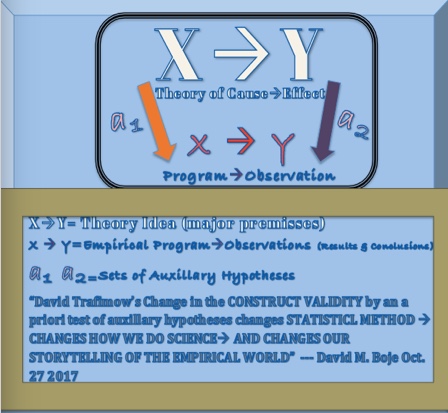
Figure 7: The New Copernican Revolution (See Deleuze study guide)
There are entangled double loops between the social and the economic factors and between the quality and functioning of economic performance.
In Henri Savall's (1975/2010: 204, boldness, mine) 'general theory' [i.e. Big (X->Y) cause-effect that Structure->Behavior], in the search for economic efficiency and tapping human potential, there is a deeper underlying principle called "the dialectics of progress" that is linked to experiments and measurements [i.e. Little (x->y) program->observations]:
This is called the Socio-Economic Principle (in other words, Big [X-Y] cause-effect general theory). And the is a Measurement Principle we will call little (x->y) program->observation experiments and metrics. The Measurement Principle says that production goes hand-in-hand with high quality social-performance if and only if organizational change is actually measured in economic terms. There are two sets of Copernican Revolution auxiliary assumptions (auxiliary hypotheses) in SEAM:
a1 (assumption set one of auxiliary hypotheses) is that Underestimating the socio-economic tensions results in reduced economic performance, and losses in profits (this is called the Hidden Cost/Performance Principle).
a2 (assumption set two of auxiliary hypotheses) is that if socio-economic loop is ignored, the hidden costs will overwhelm economic performance and there are actual negative economic performance losses (i.e. what we call here death spiral of accumulated financial deeper roots). This is called the Economic Performance Principle.
Seventh Question: What is the positive dialectical process (aka Trilectics) in SEAM?
Henri Savall's 'positive' dialectical process (1975/2010: 27) began in 1975 (rereleased 2010) as a system-wide approach to organization-environment intervention research that goes way beyond the traditions of socio-technical systems to develop a socially responsible capitalism (Boje, 2016; Boje & Hillon, 2017). There is also a good deal of positive multiplicity interventions to control dysfunctions and make organizations functional.
It is not the same dialectical methodology as the negation dialectics by Plato, Hegel, or Zizek nor is it a Marxian historial dialectic. It is rather, a positive change to working conditions by introducing democratic modes of participation in unleashing human potential while bringing about quality and efficiency improvements. It is perhaps the only organizational change intervention that uses actual scientific measurement of results, and a priori diagnosis of structural and behavioral dysfunctions generating hidden costs and there deeply rooted financial consequences. I have been teaching this approach at New Mexico State University for 19 years, with a special Memorandum of Understanding (MOU) between our university and Lyon III and the ISEOR Institute in Lyon, France.
Savall, H. and Zardet, V. (2008: 7) focus on the [positive] dialectic movement of reality in scientific progress, but attempts to avoid errors of realism and perception, as well as reductionism of empiricism by the qualimentrics of trilectic interplay of qualitative, quantitative, and financial measures.
Boje, David M. (2016). Preface to Savall and Peron. “Global Capitalism is Unsustainable". Click here for pdf And click here for the final version of the Preface in Savall, H., & Peron, Michel. (2016). Socially Responsible Capitalism. London: Routledge. (No. hal-01140272).
Boje, David M., & Hillon, Yue C. (2017). The Fifth Epoch: Socio-Economic Approach to Sustainable Capitalism. Markets, Globalization & Development Review, 2(1): 1=20. Click here for online pdf.
They conceive of [positive] dialectics as the “quality of a dialectical to-and-fro process, from the coherency and the relevance connecting the objective, the method and the analysis… interpretation of the operations and possible evolutions of the organised system they study” (Savall & Zardet, 2008: 70).
The positive dialectics of reason (as opposed to fiction) is not driven by suspicion,is radially anti-platonism, and against the ideological consolation that false generalities confer ((Savall & Zardet, 2008: 74). The work of self-critical reason consists in surmounting its own unreasonable projections.
This is a positive dialectics, similar to Follettian dialectic, that is the interplay of practical findings from application with academic canons in a “conflict-cooperation dialectical system” to sort a zone of convergence (Savall & Zardet, 2008: 80).
SEAM strives for a “dialectical synthesis embracing constructivism and positivism, since its researchers approach the study of complex problems equipped with a process-oriented model…. a mere methodological tool utilised in new research work to facilitate scientific observation of the research object that is spectre to each researcher on the team” (Savall & Zardet, 2008: 334).
In the diagnostic, and alternating “moments of introspection with periods of exteriorisation of production… this dialectic plays a role in the production of cognitive value-added, thanks to inter-researcher dialogue in particular” (Savall & Zardet, 2008: 145).
There is a positive dialectics in qualimetrics of two movements: the movement of rational analysis (analytic & deductive reasoning), and the second movement of (inductive-type) synthesis, with descriptive hypotheses, explicative hypothesis, and prescriptive hypothesis (Savall & Zardet, 2008: 186). The positive dialectics has a proposition for a synthetic framework that combines qualitative, quantitative (& financial) approaches with general concepts and contextual knowledge (Savall & Zardet, 2008: 199).
The socio-economic approach to management (SEAM) … is designed, through its formal characters, to modify the conflict-cooperation dialectics in the organization, enlarging the zone of convergence among actors (e.g., executive directors, management, shop floor personnel, labor representatives” (Savall & Zardet, 2008: 208, Hidden Costs book).
Savall and Zardet take a scientific approach to organizational intervention, based on diagnostic, joint planning, project implementation, and evaluation of results based on qualitative, quantitative, and financial (qualimetrics, itself a trilectic, rather than dialectic).
“It therefore seems more relevant to base the level of objectives for a given person, in dialectical fashion, on both the level currently attained by that person and the level expected by the firm (strategic objective)” (Savall & Zardet, 2008: 237, Hidden Costs book). The premise is that the interventions can make an organisation decidedly more democratic, and this dialectic of objectives is accomplished by doing negotiated contracts, in relation to individual outcomes achieved, known as Periodically Negotiated Activity Contract (PNAC) and a program of experimental research (diagnosis of dysfunctions, hidden costs, financial outcomes)
In short the positive dialectic is based on democratic implementation, negotiated incentives from results contracted, and carefully planned experiments (Savalll & Zardet, 2008: 306p. 306) change interventions done in teams) to develop quality, efficiency, and performance (outcomes).
It is at its heart a positive dialectical approach that does not endorse speculative markets, but rather prefers investments in productive markets (Boje, 2016 Preface to Savall & Peron's Socially Responsible Capitalism. This dialectical approach begins in 1975, when Savall decided systems theory and change management needed an socioeconomic perspective: "A socioeconomic perspective on strategic organization change reintroduces economics as part of a new dialectic to question the inevitability of speculative markets" (Boje & Hillon, 2017: 12). Savall's socioeconomic approach is to take sociotechnical systems theory and put it into a positive dialectic (Savall, 1975/2010: 202-204) by the sublimation to the sociotechnical (intrinsic/extrinsic working conditions) into a higher order socioeconomics (internal & external environment) relationship and process ontology.
Boje, D. M. (2003) Qualimetrics Contributions to Research Methodology: Preface to RECHERCHE EN SCIENCES DE GESTION: OBSERVER LOBJET COMPLEXE APPROACHE QUALIMETRIQUE by Henri Savall and Veronique Zardet, Lyon 3 & ISEOR, June 19, 2003; Revised June 26, 2003. Online prepublication draft. Here are relevant excerpts form my Preface:
"I see parallels in Savall and Zardet's work and that of Kenneth Burke. In Burke's Attitudes Toward History (1937/1957), for example, the "Law of Excluded Middle" is developed. Burke's approach involves looking at the terminological clusters on both sides of an ongoing dialectic (1937/1957: 232-236). In qualimetrics the 'excluded middle' is a trilectic, the terminological clusters between qualitative, quantitative, and financial... he point of dialectic (or trilectic) logic and thinking is to break out of the coercive and hegemonic aspects of dualistic-logic, as it is registered by discourse analysis. Merely juxtaposing point and counter-point (quantitative, qualitative, or financial) is not dialectic, it is just another form of dualism. What is important is not the synthesis, but the context of the trilectic... Therefore, my reading of qualimetrics is that it changes the rules of the research game (the logic that embeds actors in their social and economic context). This is done through long-term intervention research that keeps integrating financial with quantitative and qualitative traces of how information is produced and distributed, and how systems of reporting distort the processes they represent"
"Ethnostatistics, for Gephart (1988) is the study of how statistics are constructed, displayed (or used), and interpreted by researchers. While the context of ethnostatistics is primarily in social scientific research, it can also apply to intervention research. 'Ethno' means actual behavior of an informal subcultural, folk and looks at the activities of producers and users of numbers (Gephart, 1988: 10). Qualimetrics, like ethnostatistics is concerned with mundane, everyday life practices, with lay and professional knowledge necessary to implement and use statistics (Gephart, 1988: 10)."
Gephart, Robert Jr. (1988). Ethnostatistics: Qualitative Foundations for Quantitative Research. Qualitative Research Methods Series #12. Newbury Park, CA: Sage.
In sum, measurement before and after, each and every change intervention experiment, is fundamental to Savall's socioeconomic approach to management, known as, SEAM. It is not only quantitative and financial, the researcher-intervenor (Savall does not use terms like action researcher or change agent). The qualitative component includes the researcher-intervenor collecting verbatim qualitative field notes and direct observations, then entering them in a SEAM diagnostic computer data bank, that can be analyzed for each 'Mirror Effect' meeting with the client, when the quantitative (hidden costs), financial data, and qualitative quotes from all stakeholders is 'mirrored back' to the client, so they can see what it is costing the organization to remain dysfunctional, not converting hidden costs and revenues into realizable economic performance. When Grace Ann Rosile and I and interviewed Henri Savall and wrote an article about it we discovered something important, not in any of the Savall books. That is, that Savall looks at the qualitative discourse of an organization as a theater-script that is all disorganized and dysfunctional. We call this the 'Theatrics of SEAM' (Boje & Rosile, 2003).
Boje, D. M. & G. A. Rosile (2003). Theatrics of SEAM. Journal of Organizational Change Management. Special issue Socio-Economic Approach to Management, Henri Savall (Guest Editor). Vol. 16 (1): 21-32. Pre-publication PDF of this article; Workshop manual at http://business.nmsu.edu/~dboje/theatrics/manual/THEATRE OF SEAM 27JUNE02.DOC
Savall is all about positive multiplicity (akin to early Deleuze, Follett, & Bhaskar) in our studies this term).
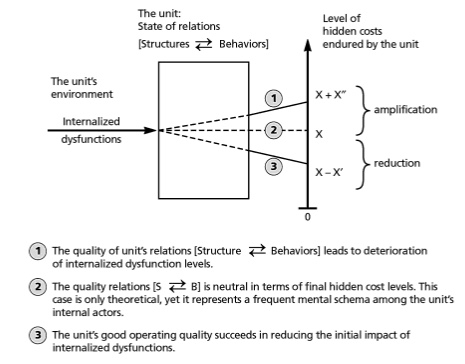
Figure 8: Prism Effect of Multiplicity: Multiplicity of Dysfunctions (Structures --> Behaviors) yeild a Multiplicity of Hidden costs (Savall & Zardet, 2008: p. 130 Hidden Costs Book).
Savall, H., & Zardet, V. (2008). Mastering hidden costs and socio-economic performance. IAP.
“… our in-depth studies on multiple micro-space operations show that the operational quality of the micro-space that internalizes exogenous dysfunctions (those of external origin) has a ‘prism’ effect” (Savall & Zardet, 2008: p. 130 Hidden Costs book).
In simple terms, Savall thought is highly critical of the sociotechnical systems theory of the 1970s for ignoring the financial and economic environment. When I interviewed Savall, he said is definitely not Marxist in his dialectical intervention. Savall does not often mention dialectic after this early work written in 1975, then revised in 2010. Another dialectic developed is in Savall and Zardet (2011) Qualimetrics, the dialectic between qualitative and quantitative organizational systems research.
"The dialectics of progress (after all, unions, enterprises, and the Government all wish to reduce unemployment and to increase production and profits... then we must demonstrate scientifically and not only according to a simple metaphysical scheme vaguely and abstractedly assessed that: a change of structure is desirable and possible *here, we mean the improvement of working conditions); when this change occurs, it brings social efficiency and economic efficiency, or at least it does not spoil economic efficiency" (Savall, 1975/2010: 204, boldness, mine).
THE OVERALL INTEGRATED MODEL OF SCIENTIFIC METHOD OF SEAM CONSULTING TO SMALL AND LARGE BUSINESS
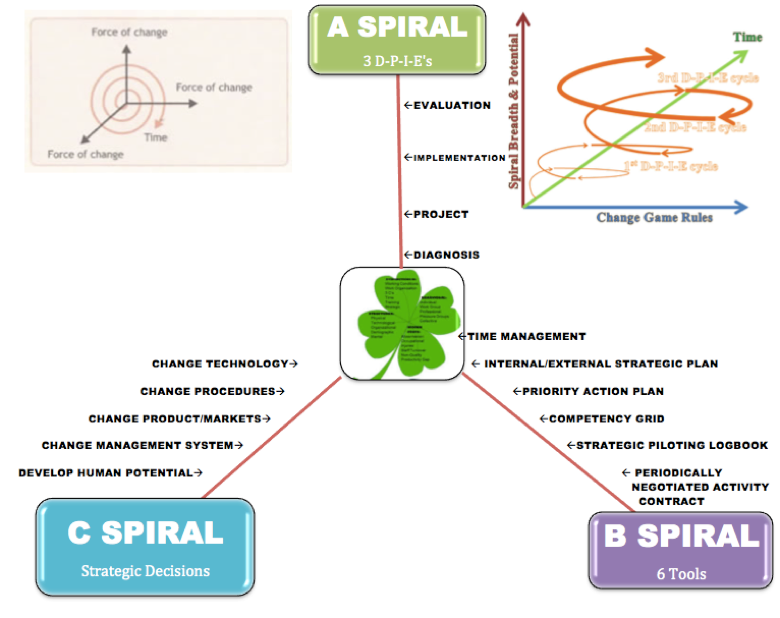
Figure 9: A SPIRAL (3 DPIEs) B SPIRAL (6 SEAM tools used by client and consultant) and C SPIRAL (5 Strategic Change Decisions of client) of SEAM, showing the force momentum of change by looping through all 3 spirals, from the 4-leaf clover diagnostic to periphery (drawing by D. M. Boje)
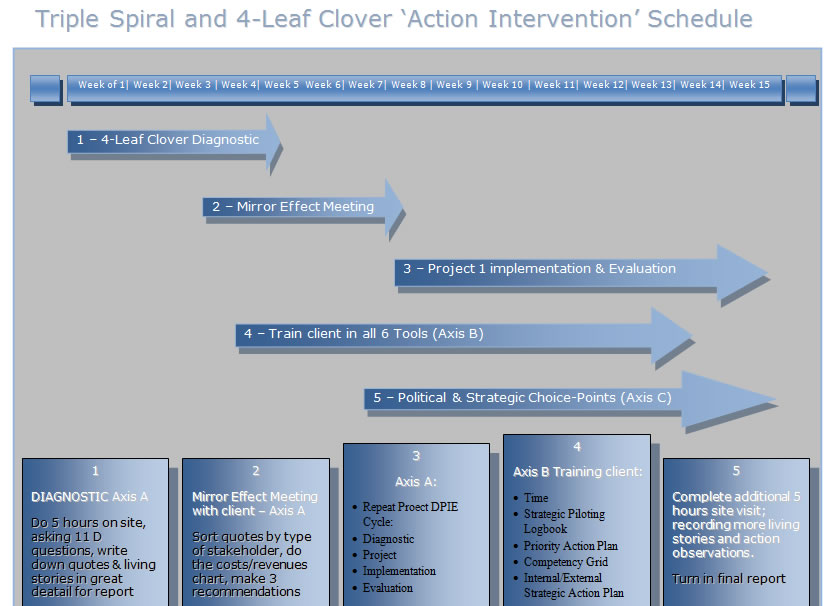
Figure 10: How the SEAM Triple Spiral Intervention is implemented in 16 week course for undergraduate and masters students who work in teams to help 10 to 15 clients a semester (original drawing by D. M. Boje)
In sum, the Spiral, Gyre, Helices, and Vortices are entangled. Charles Minahen (1992) has written an amazing history of spirals in literature. His appendix makes distinctions and interplay between spirals, vortices, helices, and gyres. Spirals are usually 2-dimensional renditions (a coil of rope), but Gyres, and Helices have one axis, and Gyres are 3-dimensions, and the Vortices of Turbulence need a 3-D Spiral Vortex to depict socio-economic change and performance interventions. I therefore propose double-spiral helix rendition. Sometimes these four (Spiral, Gyre, Helices, & Vortices) forms are in symmetrical-complementarity relations, and other times quite asymmetrical (enantimorphism, technical term, for co-existence of two or more forms), and they can have a handedness (left-handedness and/or right-handedness) that is anthropomorphic (because spirals don't have hands). Does a spiral have a left and right side, as Deleuze (1994, Difference & Repetition) suggests? Are the forces of rotation and motion moving left and or right? Are spirals symmetrical or more asymmetrical, or perhaps both at once? A human body has symmetric right and left side, but asymmetric front and back. My hypothesis is following the theory of Enantiomorphism, the organizational systems have asymmetrical structures and also symmetrical structures. They are both left and right-handedness helices of momentum more than single momentum or single rhythm, or just an upward without some downward. The double-spiral helix is in several directions of gyration, depending on the turbulence of the situated environment. There is double-spiral movement within, and the movement along a path that is hermeneutical, a change in paradigmatic and storytelling trajectory from here-and-now to then-and-there. For Deleuze this is not about thesis and antithesis, its about multiplicity of symmetrical and asymmetrical forces, as the periphery changes in relation to centripetal movement by some center (axes). I theorize the double spiral as having opposing dynamical vortical manifestations, spins in opposite directions give the type of turbulence affecting centripetal and centrifugal interplay.
Next I combine the chart above (p. 205) with one depicting socio-technical system (p. 129). Chart 129 is a Venn diagram with 4 intersecting circles (individual psychology, (inter-)group, organization behavior, & technology management). Below I show how chart 129 can be combined with the figure on p. 205.
Figure 11: Savall expansion of Socio-Technical-System theory within a broader Economic System together with individual, group, organization, and management technology systems (Boje's adaptation of Savall (1975/2010: pp. 129, 205) charts, © D. M. Boje, 2017)
At center is socio-technical-systems, where the 4 circles overlap together. What is important here is that Savall, being an economist, began to to critical of socio-technical systems (STS) ignoring the socioeconomic entanglements, and reducing organizational systems to just individual psychology, group (inter-group) systems, and managed technology systems. The result is socioeconomic systems get reduced to socio-technical systems.
What I think can do is investigate the connection between these 2 charts, so we can initiate a conversational interview with Henri Savall on where this might lead, in terms of the double spiral. On p. 205, Savall speaks of the explosive spiral that expands (what I call centrifugal force) and the implosive spiral that centers (what I call centripetal force). The diagram has one set of these two forces that go in same direction and another spiral force set where the two forces are in opposite direction to each other. This, to me, is the socioeconomic that would entangle and contextualize the p. 129 4 circles of sociotechnical systems.
The socio-economic double spiral is thus the explosive-centrifugal spiral in opposition or alignment with the implosive-centripetal spiral of organization in its economic environment of economic resources, economic products (& services), and situated in spacetime of sociomateriality (see Boje, 2016 Organizational Change & Global Standardization).
PART II: MILITARY SANDTRAY APPLICATIONS OF SPIRALLING DOWN AND UP
Sandtray Embodied Restorying Process (ERP)
Embodied Restorying Process (ERP) has five phases. See Flora, Boje, Rosile, & Hacker (2016) article.
Phase 1: Story Generation (non-verbal) Veteran and family members (spouse, parner, children) create their own individual standtray material object assemlies and can do so sliently, sepaking about their assemblage or not. In Phase 1, family members and veteran choose one or more materail objects to represent themselves. It seems to work best if the assemblages, the choosing of material objects, and putting them into relationality is done in silence. This stimulates relfexivity. At this phase the sensemaking is individually accomplished, and it is about the psychical autopoiesis.
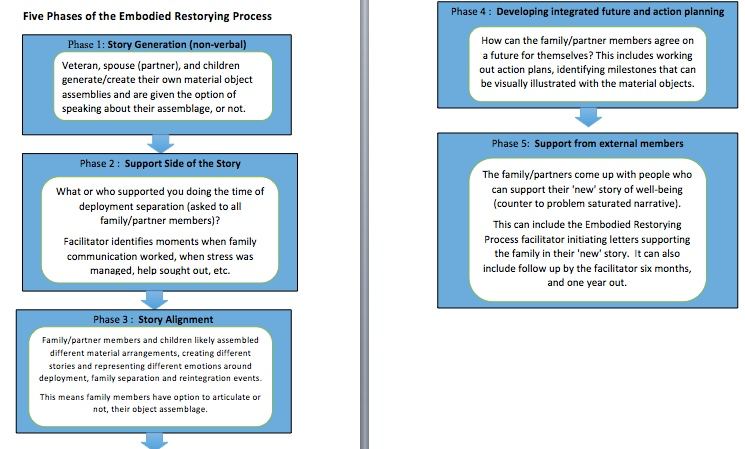
Figure 12: 5 Phases of Embodied Restorying Process (figure part of grant application © Boje, Rosile, Flores, Hacker, Ketalaar, and Wazlawek, 2017).
Phase 2 Support Side of the Story This is a transition from psychical to sociocommunicative autopoiesis, to more specifics of what or who supported each family mamber and veteran during deployment separation. It is part of the restorying process in recalling moments of exception to being stuck in the past, or being unable to move forward. It is a critical phasis of moving out of unembodiment back into embodiment. In Phase 2, clients can take objects out of, and/or add new material objects to their assemblage to show the support side of the story.
Phase 3: Story Alignment In thier biophysical autopoiesis, there is instinctual attunement of extended biophysical inseparability. Sandtray works helps the family system engage in their own autopoietic interpretations. The famly members' and veteran's own material object assemblages will be quite different, which invokes energy for story alignment: how to unify the differences across the actor-actant network assemblages (See Latour Study Guide). There is dyanamic cause interplay between what Peirce calls effiecient and final causations, as well as the form and material causations (all four make up Aristotle's fourfold causes). Heidegger (1977) finds a fith cause, that of revealing, disclising a more fundamental ontology relation. The five causations (efficient, final, material, form, and reveal) are instantiated in the sandtray assemblages. The five causations are coupled, networked in the assemblages. In other words, the biophysical autppoiesis has its internal dyanmics and its environmental relations, since each human is inseparable from the biophysical environment. Peturbations in the body are attuned to perurbations in the extended ecosystem. The three autopoietic systems receive dynamic inputs, which act as transient perturbations to one another. The assemblages, theri re-configuring trigger internal sensemaking autopoietic changes, and have effects on the sociocommunicative networks in which veteran and family members are embedded. The very organization of the triadic autopoietic family system in relation to biophysical autopoietic system has important dyyamics worked out in acts of story alignment. As veteran and family members explore story assemblage differences, and come upon ways to unify differences, thare are also some differences that remain unintegratable. There are contradictions between the story assemblages. The entire family can engage in what Rosile, Boje and Nez (2016) call 'ensemble' a teogetherness approach to their storytelling, fashioning a common assemblage.
Phase 4: Developing Integrated Future and Action Planning How can the family members agree upon a future for themselves. The purpose of embodied restorying process (ERP) is to gather little wow moments of exception to the problem-saturated narrative, that can be gathered into 'new story' of the future. Stuck in the past trauma, and stuck in story disalignment, the family cannot restory an integrated 'new' story of their future. This phase involves visually assembling and integrating action plans, identifying milestones, and continuing the process of story alignment. It is also a transition from retrospective sensemaking of the past into prospective sensemaking, what we call antenarrating bets on the future. Phase 4 has the family members develop many alternative futures, so that their is freedom of choice, and working out which future among alternative futures the family inends to bring into Being.
Phase 5: Support from External Members In the final sessions, family members develop support network of external members who can support thier new story. This can include the ERP facilitator initiating letter writing in support of the new story. It involves followup six months and a year out.
Family rhythms and all three autopoieses (psychical, sociocommunicative, & biophysical) are disrupted by deployment, the family system is left out of balance. Embodied Restorying Process (ERP) is a way to bring the family stories into alignment. The ERP approach addresses the three autopoietic systems, from the vantagepoint of embodiment and unembodiment. In combat deployment, veterans often leave parts of their soul overseas. They get embodied in the military as their primary family, and find it diffiult to reembody their home-family. The purpose is to align the three autopoieses (psychic sensemaking, sociocommunicative networking, & biophysical somatics) to bring health to the emboidied living system of the family.
The whole autopoietic system is organized (all three autopoieses in integrative unity) in a network of relational process ontologies (RPOs). These RPOs intra-act in spacetimemattering assemblages. ERP allows for materail object assemblages of the family members to work through transformation that regenerate family system dynamics and networks of hibituated relational processes. For example, a combat veteran may elect, after deployment to withdraw for social realtions with the family, being more comcomfortable with other veterans (military family) than with home family. The trauma of biophysical (PTSD, TBI, Military Sexual Trauma, etc.) disrupts biophysical autopoiesis. which affects the psysic and sociocommunicative autopoetic systems. The three autopoises constitute a whole system in spacetimemattering. The sandtray work is a topological landscape, timescape, and materialscape for realizing changes in indidividual, family system, and military and medical institutional dynamics.
Flora, Jeanne; Boje, David M.; Rosile, Grace Anm; Hacker, Kenneth. (2016). Theoretical and Applied Review of Embodied Restorying for Post-Deployment Family Reintegration. Journal of Veterans Studies. Vol 1, No 1, online at http://veteransstudies.org/journal/index.php?journal=jvs&page=issue&op=view&path[]=1
Rosile, Grace Ann; Boje, David M.; Nez, Carma Claw. (2016). “Ensemble Leadership Theory: Collectivist, Relational, and Heterarchical Roots from Indigenous Contexts.” Leadership journal. click here for pre-press version.
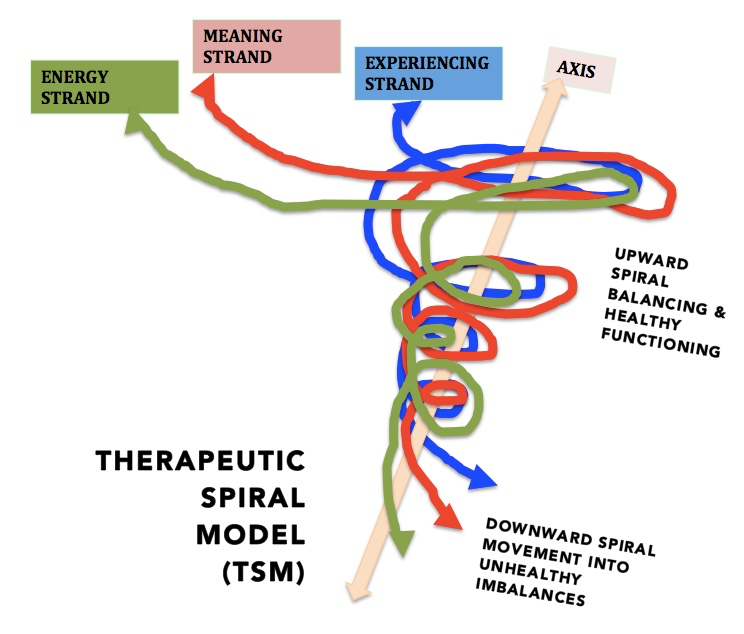
Figure 13: The Downward and Upward Spiral Model of Reintegrating Military Families after Deployment(drawing by D. M. Boje, 2017)
Hudgins, M. K. (2000). The therapeutic spiral model: Treating PTSD in action. In P. F. Kellermann & M. K. Hudgins (Eds.), Psychodrama with trauma survivors: Acting out your pain (pp. 229–254). London: Jessica Kingsley.
Hudgins, Katherine J. (2002). Experiential Treatment For PTSD: The Therapeutic Spiral Model NY: Springer Publishing Company, Inc.
Hudgins, Kate; Blatner, Adam’ and Toscani, Francesca. (2013, Eds.). Healing World Trauma with the Therapeutic Spiral Model: Psychodramatic Stories from the Frontlines. UK: Jessica Kingsley Publishers.
(Hudgins, Blatner, & Toscani, 2013:
Hudgins and Toscani (2013, chapter 2) explore TSM operates within a “larger story” people feel stuck and hopeless” and Vulnerable” in pre-therapy lives (p. 13). TSM and ERP are ways to help a military veteran and family members assemble their pre-narrative fragments, and to tell their story.
Higgins (2002) Therapeutic Spiral Model (TSM) is a clinical treatment for trauma survivors. He spiral image is a DNA model with three interwoven strands revolving around an axis, in up and down direction and intensities (Hudgins, 2002: p. 38-39).
“The spiral image and structure maintain the balance of thinking and feeling that is crucial to the use of all action methods with trauma survivors” ((Hudgins, 2002: p. 41).
There are three strands of spiral: “energy, experiencing, and meaning” ((Hudgins, 2002: p. 41). The 3 stranded visual spiral gives order to the chaotic
“The spiral image and structure maintain the balance of thinking and feeling that is crucial to the use of all action methods with trauma survivors. There are six action experiences that are presented to build energy, increase experiencing, and increase making making” ((Hudgins, 2002: p. 41).
“The therapeutic spiral is a visual image toehold bridge the gap between active experiencing of trauma bubbles and the narrative labelling needed to complete cognitive processing” ((Hudgins, 2002: p. 41).
The three strands image of spiralling “provided a simple order to the chaos of fragmented trauma perception, thoughts, feelings, and the primitive defences that follow them” (p.41). For example the energy spiral-strand can be assessed as “helpful or not” the trauma experiencing spiral-strand can be labeled as “too much, not enough” and the meaning spiral-strand, “does it make sense or are you overwhelmed” (p. 41). In sum, all experience can be labeled by the client as either energy, experiencing, or meaning. This allows the therapist to “guide the process into positive, upwardly spiralling direction of attention and focus” ((Hudgins, 2002: p. 41).
My question: can this be done using sand tray method of ‘Embodied Restorying Process’ (ERP). Can the Therapeutic Spiral Model (TSM) be combined with ERP?
The experience (PTSD, TBI, MST) of flashback “being sucked into the spirals of the past, while stuck in the present” (p. 41). The therapist can help the client “discriminate between the experience of the pull of the past and the choice to instead focus on the heart and now” ((Hudgins, 2002: p. 41).
In sand tray work, the trauma is frozen in team, with the spiral-strands of energy, experiencing, and meaning not interacting or blending, and instead becoming crushed or fixed by the trauma. A conscious movement by the client, up and dow the triple-stranded spiral, has become “stuck, chaotic, and unpredictable: ((Hudgins, 2002: p. 41).
STRAND 1: Energy - The first spiral-strand, energy, of the TSM, “is the fuel for all growth and development” and is “defined as spontaneous state of learning and is activated by enactment of the prescriptive roles” and can focus on spirituality (Hudgins, 2002: p. 205). If there is too much energy, then TSM interventions can help “contain and decrease intrusive affect and memories” (Hudgins, 2002: p. 54). The spiral of energy is a way to contain and move from a chaotic tornado or repetitive energy into a consciously controlled upward spiral that breaks the repetitive energy cycle (Hudgins, Blatner, & Toscani, 2013: 93). Spiralling energy is a journey of a “trauma survivor from hell to healing” (Hudgins, Blatner, & Toscani, 2013: 20).
“The fabric of TSM is strong, woven by many hands while the Spiral’s three strands represent the there basic and far-reaching elements of the work — Containment, Experiencing, and Meaning-Making” ((Hudgins, Blatner, & Toscani, 2013: 20).
Containment focuses on energy awareness on the here-and-now (too much affective energy or not enough spontaneous learning energy). In Embodied Restorying Process (ERP), the energy of the family can be stuck in repetitive habit cycle, especially post-deployment, is a kind of vitality, ways of relating, interacting, and communicating, sharing, and caring by family members that channels energy from chaos and repression, to coping and expression in ways that creates positive energy balancing. For TSM, energy containment using “timeless images of spirals” is a way of using symbols in collectedly healing downward spiralling energy. (Hudgins, Blatner, & Toscani, 2013: 20). The overflow of energy in trauma roles of a family and shamanic energy in TSM intervention can be effective (Hudgins, Blatner, & Toscani, 2013: 81).
STRAND 2: Experiencing - The second, experiencing of the spiral, is what the person is actually experiences in a traumatic situation, not on what stressor caused the event ((Hudgins, 2002: p. 10).The second strand “describes the experiential processes of internal awareness of sensations, perceptions, thoughts, feelings, and actions ((Hudgins, 2002: p. 205) The second spiral-strand is safely concretising experiences of trauma. Are the symbolic representations of experiencing attached to realistic goals and expectations about self and others ((Hudgins, 2002: p. 46)? This is similar to ERP, where the family members, work organization, and military institution, and society, have expectations that the veteran and family internalise as narrative identities.
Experiencing process diagnosis: “Are there enough positive roles to support increased experiencing? If yes, then ask the protagonist to concretize a scene” (Hudgins, 2002: p. 54). In TSM this is done with psychodrama role-playing (client with a body double) doing imrprov theater. In ERP sand-tray it is done with material objects in an assemblage the client constructs, and interprets, if confortable.
ERP in sandtray work gives a method for renegotiating the organizational (or institutional) system expectation of veteran and family roles and what Bakhtin (1991, 1993) calls ethical answerabilities. (Hudgins, 2002: p. 47) indicates that sand-trays, clay models, and college are options, along with psychodrama, modified and used as part of a whole weekend workshop experiment and medium for working through TSM based on the spiral image. Sensemaking distortions: “intense dissociated feelings, body memories, flashbacks, primitive defences, ego state change, and even unconscious repetitions of early trauma can haunt any survivor of trauma” ((Hudgins, 2002: p. 12). The inner experiencing world can become “unsafe, remaining so long after the actual traumatic incident has ended in the outer world” ((Hudgins, 2002: p. 12). ERP is import in order to access places without worlds, unstoryable with words, and are part of embodied experiencing, that are pre-narrative and antenarrative body memories, and ways of re-experiencing the past, and the present filtered through past memories, as yet unhealed. Focusing is “an attentional skills that brings the unconscious and automatic sensations, perceptions, nonverbal behaviours, emotional nuances and impulses, into conscious awareness, and so they can be experienced and further processed” (Hudgins, 2002: p. 27). Such active and embodied experience-focusing can occur in ERP, in sand-tray work on unprocessed fragmented trauma material.
STRAND 3: Meaning - The third spiral-strand is meaning, and it “represents the ability to put narrative labels on experience to make sense out of it” (Hudgins, 2002: p. 206). How can you express meaning that is without words to put into narrative? In ERP this is done through material images. TSM also uses sand-try or clap models, or collages, or psychodrama. Each of these is a meaning-making intervention
“People live their lives based on the personal narrative they have made about past experience and their hopes of the future” ((Hudgins, 2002: p. 46). This is similar to ERP where the retrospective narrative sensemaking (stuck in the past) interferes with the prospective antenarrative meaning-making (bets on the future, ability to generate multiple futures and choose wisely among them, and work toward one of them in fore-caring in advance for their manifestation).
In sum, a Trauma Spiral is “a graphic image of the three strands of TSM impacted by trauma. IT shows explosions of energy, constrict of experience, and blocked meaning making: ((Hudgins, 2002: p. 208).
differences between Therapeutic Spiral Model (TSM) and classical psychodrama treatment PTSD and other traumas. This is relevant to our work on post deployment facility integration, since we work with the family members, their family system, with an emphasis on safety and containment, in a dramatic process of sand-tray enactment using material object assemblages. TSM often uses an empty chair, which is also part of classical psychodrama, and group psychotherapy, so that dialogue between parts o the self can take place. The double (becoming voice of what is not said by protagonists) noticing body language (clenched fist, eyes closed, etc.) is used in classical psychodrama. The ‘containing double’ is used more frequently in TSM, to do trauma repair, by protagonist becoming aware of unconscious feelings held in the bod, and then putting words to it. In ‘body double’ a member of the group, represents the unexpressed body sensations, verbally, in a psychodrama with the protagonist (client), and a director (in classical psychodrama). TSM dramas do not use an audience, how every group (family) members can used he TSM technique or move to an action healing team (p. 59) mode with representatives playing various expressed and unexpressed emotions, feelings, embodied or not.
Second question, what has all this to do with Savall’s double spiral model?
Savall’s double spiral model is socio-economic, and has upward explosive spiral and downward implosive (regressive) spiral. It seems to me that TSP and Savall’s double spiral model have some overlap and some difference we can explore.
Spiralling has 2 l’s in UK and spiraling, only one l in US spelling. http://www.tysto.com/uk-us-spelling-list.html
erapeutic Therapy Model TSM (drawing by D. M. Boje 2017)
Another kind of dialectic is developed in Qualimetrics, the integration of qualitative and metrics.
Savall, H., & Zardet, V. (Eds.). (2011). The Qualimetrics Approach: Observing the complex object. IAP.
Boje, D. M. (2003) Qualimetrics Contributions to Research Methodology: Preface to RECHERCHE EN SCIENCES DE GESTION: OBSERVER L'OBJET COMPLEXE APPROACHE QUALIMETRIQUE by Henri Savall and Veronique Zardet, Lyon 3 & ISEOR, June 19, 2003; Revised June 26, 2003 http://business.nmsu.edu/~dboje/papers/Qualimetrics_preface_Boje.htm
Boje, David M., & Hillon, Yue C. (2017). The Fifth Epoch: Socio-Economic Approach to Sustainable Capitalism. Markets, Globalization & Development Review, 2(1): 1=20. Click here for online pdf.
Boje, D. M. (2016). SEAM’s ‘Storytelling Dialectical Method’ and the Failure of Appreciative Inquiry as a Scientific Method of Organizational Development and Change. Click here for pdf of paper. Here is an excerpt from Boje (2016):
"There are three kinds of relations of positive thesis to negative antithesis in Hegel’s (1807/1977) Phenomenology of Spirit. For ease of presentation, I will call them Alpha, Beta, and Gamma in Lyon, France:
ALPHA NEGATIVITY First type is a negative that fails to account for the positive within some negative content. A good example is Appreciative Inquiry (AI), which pursues only positive stories within organization content and its diagnosis and intervention, but fails to see that the negative story has its positive aspects. SEAM, by contrast, puts great stock in negative stories of dysfunctions, proceeding to calculate the dollar amount of their hidden costs, and using that to convince client to recover those hidden costs by designing intervention projects. In its Alpha Negativity, AI fails to see the ‘negative’ in its own process as a shadow side, such as forcing people tell positive stories is itself quite hegemonic, a way to dominate discourse, and those who bring up any negative content are punished or asked to leave (see Boje, 2010; Fitzgerald, Oliver, & Hoxsey, 2010).
BETA NEGATIVITY SEAM, by contrast, is doing the second type of negative, where each negative (each dysfunction) has a movement of positive content (possible ways to produce value-added spaces, times, structures, behaviors, etc.) when considered in the whole process or System of negative (dysfunctions) and positive reclaiming of hidden costs to produce untapped revenue potential from untapped human resource development, technology investments, structural and behavioral changes, value added time management, strategic implementation, and so on. SEAM keeps digging deeper, under the surface of the Income Statement, down into the depth of dysfunctions, to find exactly where positive content can be calculated, and realized.
GAMMA NEGATIVITY This third type of negative, Hegel (1807/1977: p. 36) calls “ratiocinative thinking.” It is defined here as a skilled and methodological process of Reasoning in which there is a back-and-forth rhythm Spirit’s movement of meter and accent between positive and negative. It is this rhythm aspect of Hegel’s dialectic, its working its self-movement out in space, time, and matter (to be more accurate, in spacetimemattering that is inseparability) that we want to focus on here" (Boje, 2016: p. 6-7).
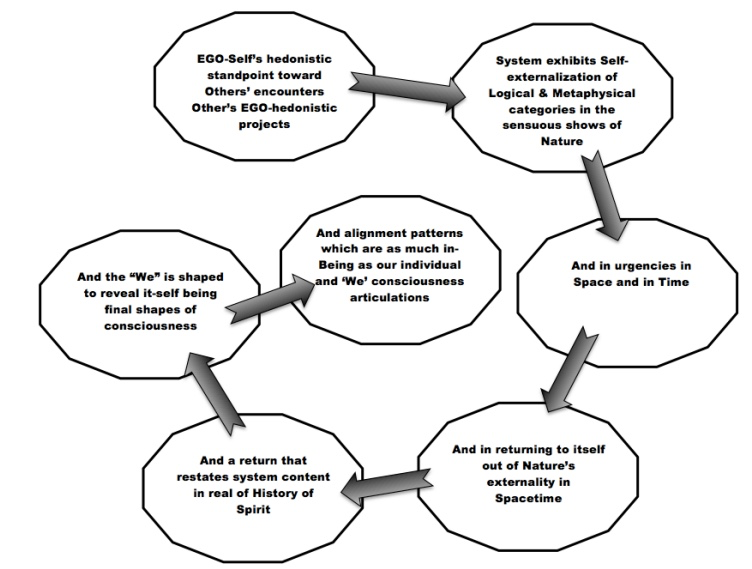
Figure 14: Hegelian Dialectics of Systemicity © 2010 D. M. Boje (p. 10)
Savall is not a traditional economist. He does not support the classic supply and demand economics of labor and technology substitutions. He is not Marxist or Hegelian in his dialectical model. Nor, is he a fan of speculation economics which he determines is responsible for taking away investment in the productive economy of organizational systems that have positive working conditions in stable economy. His dissertation and subsequent economic theory is rooted in the work of German Bonacer, a contemporary of Joseph Schumpeter and John Maynard Keynes. Savall believes that speculative capitalism is unsustainable, and results in one socioeconomic crisis after another.
Savall, H., & Peron, Michel. (2016). Socially Responsible Capitalism. London: Routledge. (No. hal-01140272).
Boje's Preface to Savall and Peron (2016). “Global Capitalism is Unsustainable". Click here for pdf And click here for the final version of the Preface
The External environment and Intrinsic/Extrinsic 'Working Conditions' are in dialectical relationships:
"Our classification, which is of necessity an arbitrary one, does not however exclude the reciprocal and dynamic relationships, and hence dialectic relationships, which exist between all these elements The three categories of conditions [external environment, extrinsic working conditions, and intrinsic working conditions] as a whole constitute an evolutive system in which the internal composition and balance depend on the possibility of carrying out the adjustments necessary for its stability" (p. 27).
Savall seeks a form of job design that is dialectically compatible with both technology and humanization of work, and the dialectic between internal working conditions and the external environment
"It is also possible to lay out a sequential development process based on the dialectical relationship between technology and job design" (p. 143).
"... we approach the dialectic between the economic advantages and the extraeconomic psycho-sociological advantages" (p. 147).
Savall's study of Renault corporation workers:
"In this way our didactic and (of necessity) dichotomous representations of the various forms or sources of propagation must not all one to forget dialectic interrelations, such as, between workers' actions (strikes) and public opinion" (p. 200).
Savall's organization-environment complex and evolutive [dialectic] system:
"But who should undertake to change the structures? Could it be one single decision-maker who, by himself, would be totally free to choose from amongst different possibilities or should it be a complex system of ... dialectical decision" (p. 203).
Savall's objective is to wrap socioeconomics around the traditional "socio-technical approach of the Tavistock Institute" that for him is not bring change to the whole organization-environment dialectic (p. 204).
"If, within the general approach, we admit that, at some point, the search for economic efficiency constitutes the dynamic principle underlying the dialectics of progress (after all, unions, enterprises, and the government all wish to reduce unemployment and to increase production and profits), then we must demonstrate scientifically and not only according to a simple metaphysical scheme vaguely and abstractedly assessed that: a change of structure is desirable and possible (here, we mean an improvement of working conditions); when this change occurs, it brings social efficiency and economic efficiency, or at least it does not spoil economic efficiency" (p. 204).
There are other kinds of dialectics, included by Savall, such as with qualimetrics, a dialectic of qualitative and quantiative (metrics) which he ironically calls 'seamless.' I have been teaching Scoioeconomics for over 18 years, going most very summers to learn mre by teaching a course doing a conference presentation or keynote in Lyon III hosted conferences.
See SEAM studyguides and images at https://davidboje.com/448/
Next:
Boje, D. M. & G. A. Rosile. (2003) Comparison of Socio-Economic and other transorganizational development methods. Journal of Organizational Change Management. Special issue Socio-Economic Approach to Management, Henri Savall (Guest Editor). Vol. 16 (1): 10-20. The purpose of this article is to compare and contrast the socio-economic approach to management (SEAM) with 15 large system change methods. All 16 of these methods are part of the transorganizational development (TD) gameboard (see the Web site at http://web.nmsu.edu/~dboje/TDgameboard.html. Based on this comparison, the paper suggests that SEAM is broader-based, more integrative, and more postmodern (more multi-vocal and power-conscious) than most other TD methodologies.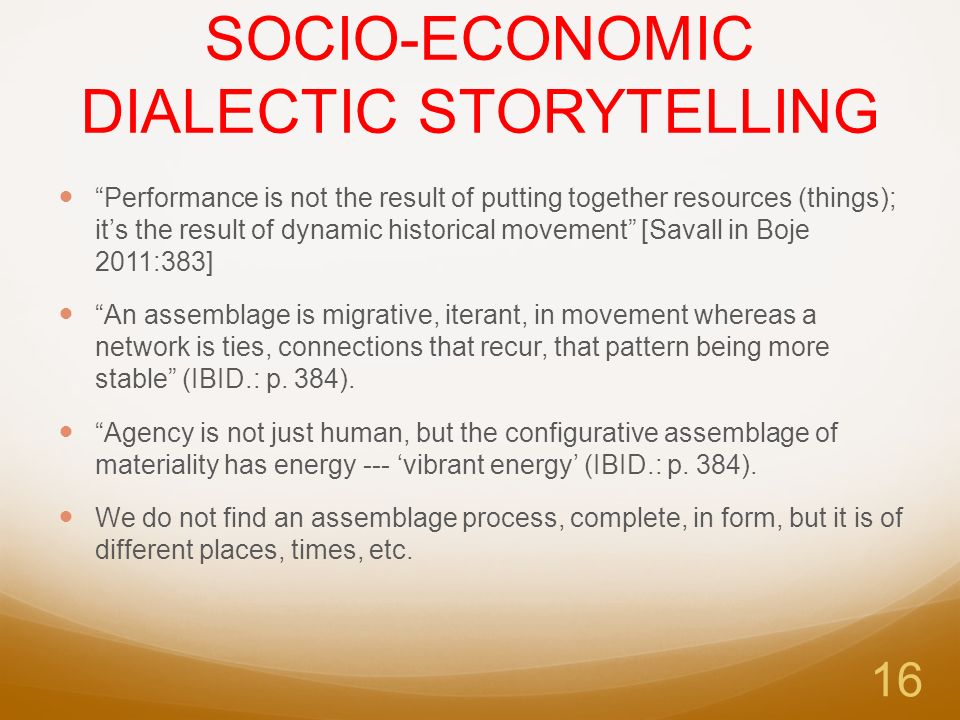
Boje, D. M. & G. A. Rosile (2003). Theatrics of SEAM. Journal of Organizational Change Management. Special issue Socio-Economic Approach to Management, Henri Savall (Guest Editor). Vol. 16 (1): 21-32. Pre-publication PDF of this article; Workshop manual at http://business.nmsu.edu/~dboje/theatrics/manual/THEATRE OF SEAM 27JUNE02.DOC
For more SEAM at more particular understanding, next:
Boje, D. M. (2003) Qualimetrics Contributions to Research Methodology: Preface to RECHERCHE EN SCIENCES DE GESTION: OBSERVER LOBJET COMPLEXE APPROACHE QUALIMETRIQUE and in English version - The Qualimetrics Approach: Observing the Comp… by Henri Savall and Veronique Zardet, Lyon 3 & ISEOR, June 19, 2003; Revised June 26, 2003 http://business.nmsu.edu/~dboje/papers/Qualimetrics_preface_Boje.htm
Savall, Henri, Zardet, Veronique, & Bonnet, Marc. (2008). Releasing the Untapped Potential of Enterprises Through Socio-Economic Management. ISBN 978-2-917078-12-9 2nd Revised edition, 2008 London: International Labor Organization and Socio Economic Institute of Firms and Organizations.
Worley, C. G., Zardet, V., Bonnet, M., & Savall, A. (2015). Becoming Agile: How the SEAM Approach to Management Builds Adaptability. John Wiley & Sons.
Savall, H., & Zardet, V. (2008). Mastering hidden costs and socio-economic performance. IAP.
Savall, Henri. (1975/2010). Work and People: An Economic Evaluation of Job-Enrichment. Translated from the French by M. A. Woodhall. A volume in Research in Management consulting. Series Editor: Anthony F. Bruno Charlotte, NC: Information Age Press.
For Current work on SEAM:
Savall, H., & Peron, Michel. (2016). Socially Responsible Capitalism. London: Routledge. (No. hal-01140272).
Boje, David M. (2016). Preface to Savall and Peron. “Global Capitalism is Unsustainable". Click here for pdf And click here for the final version of the Preface in Savall, H., & Peron, Michel. (2016). Socially Responsible Capitalism. London: Routledge. (No. hal-01140272).
David M. Boje and Yue Hillon. (2017). "The Fifth Epoch: Socio-Economic Approach to Sustainable Capitalism" (MS #1029) has been published to Markets, Globalization & Development Review, Vol 2 (2), online. Abstract The purpose of this conceptual essay is to challenge the inevitability of living with the destructive beast of speculative market economics in the 4th epoch of global capitalism. We are facing an existential socioecological threat from the short-term excesses of financial capitalism, a socially irresponsible form that consumes without producing value and without bearing entrepreneurial risk, benefitting only the few. The fate of roughly 90% of humanity hangs in the balance. The primary contribution of this paper proposes a 5th epoch of capitalism, inspired by Savall and Zardet’s socio-economic and sustainable approach that restores human potential and value creation to spacetimemattering. Applying their conceptual innovation moves capitalism to a Bernácer-Perroux economic universe, with a different curvature capable of reconfiguring organizational story spacetime and resituating the antenarrative of global capitalism. Keywords Capitalism, socio-economic, sustainable, human potential. http://digitalcommons.uri.edu/mgdr/vol2/iss1/2. Direct link http://digitalcommons.uri.edu/cgi/viewcontent.cgi?article=1029&context=mgdr
